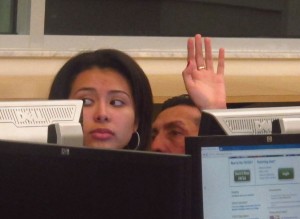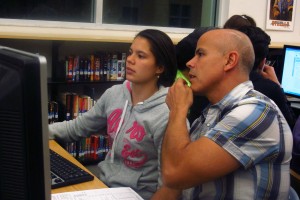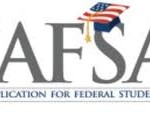Why Paperwork Is Worth Millions To Florida College Students
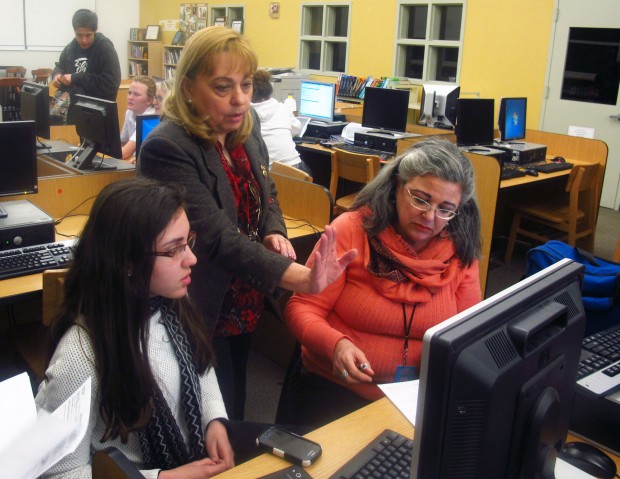
John O'Connor / StateImpact Florida
Miami Beach Senior High college adviser Maria Sahwell helps Anahi Hurtado, left, and her mother fill out the FAFSA.
It’s a midweek school night at Miami Beach Senior High School.
Students, their parents and siblings — roughly 80 people in all — are waiting in the school’s library to get on a computer and answer a lot of questions.
Miami Beach Senior High college adviser Maria Sahwell and experienced counselors will walk families through filling out the Free Application for Federal Student Aid, or FAFSA.
By this time of year many high school seniors have already sent in their first college applications. Now, the question is how to pay for it. And for most that means the FAFSA.
But half of Florida high school graduates don’t complete the form, losing out on at least $100 million dollars for college each year.
Anahi Hurtado wants to study political journalism. She and her mother, Susy Riener, quickly run into their first obstacle.
“Do I have to add all the universities right now?” she asks, still weighing her options.
Monaud Daphnis, the financial aid director at Miami Dade College’s Wolfson Campus, tells her she does — and that she should rank her preference. Some colleges and universities base their financial aid offers on those student rankings.
Hurtado quickly has to choose which schools are most important to her.
She runs down the list with her mother: George Washington University, University of Florida, Florida International University, Virginia Commonwealth University, American University. The list goes on.
Eight Miami-Dade high schools are holding a series of similar sessions this winter and spring. The program is funded by the Miami-based Education Fund.
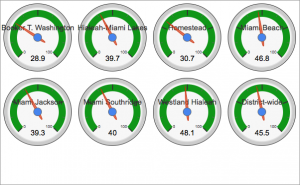
John O'Connor / StateImpact Florida
This chart shows how seven high school holding FAFSA marathons compare to the Miami-Dade completion rate. Click the photo to enlarge.
It’s just one of many efforts across the state to increase the percentage of students who fill out the FAFSA. Statewide, 49.6 percent of high school graduates submitted an application last year.
That’s decreased slightly over the past few years. And because Florida has more low-income students than most states, students are missing out on a pile of money – the Florida College Access Network says at least $130 million in federal Pell grants.
That’s free money for college. It doesn’t need to be repaid.
Many have said the form should be simpler. U.S. Senator Lamar Alexander from Tennessee talked about how he would change the FAFSA during a session last month.
Alexander dangled the eight-page application as he spoke from the Senate well, letting it rattle and rustle as he made his points.
Alexander wants to condense the FAFSA to a postcard.
“It will turn these [one] hundred eight questions into two: One about amount of family income. And one about size of family,” he says.
Any changes to the FAFSA are likely years away, but Miami Beach Senior High college counselor Maria Sahwell says they’d be welcome.
“That’s the way it should be,” Sahwell says of the two-question FAFSA. “Who cares about everything else?”
Research finds the wealthiest and poorest students are the least likely to complete the FAFSA.
The biggest reason students don’t fill out the form is because they assume they won’t be eligible for money, says Troy Miller, with the Florida College Access Network.
“You don’t know if college is affordable until you fill it out,” Miller says.
Other students struggle to answer all the questions, which require detailed tax information: what parents earn; checking account balances; the value of real estate — but not the house you live in; the parent’s net worth — but don’t include any farms with fewer than 100 employees. Et cetera.
The Florida College Access Network has been posting school-by-school FAFSA completion figures on its website.
This year for the first time, Miller says Florida schools will be able to track whether each student has filed their FAFSA yet. They want 10 more students at every Florida high school to submit the application. If that happens, it will mean an additional $10 million in Pell grants.
At the Miami Beach FAFSA marathon a handful of students walked out before finishing. One student, Charley Zaragoza, is a French citizen attending U.S. schools on a visa. He doesn’t have a Social Security number and didn’t realize you needed one for the FAFSA.
Advisers tell him he’ll need to contact schools directly about financial aid for foreign students.
“I found out now so I don’t have to worry about it,” Zaragoza says, “but I don’t think it will slow me down. It’s all right.”
About 90 minutes into the FAFSA marathon, the first families submit their applications.
The federal Education Department estimates it should take 55 minutes to fill out the FAFSA for the first time. Students have to fill out the form every year they’re in college — those subsequent submissions should take 45 minutes.
Anahi Hurtado has trouble finding the right income figure for her mother and father, Horaceo. They check the 1040 tax form, but that has both business and personal income added together. They need W-2s.
Finally, they track down the right figures.
They submit Anahi’s FAFSA nearly two hours after arriving.
“The website didn’t… tell you where you needed [to look] – the people are the ones that told you ‘It’s from here’ ‘It’s from there,’” Anahi Hurtado says.
Her father says the form takes time, but isn’t that daunting.
“This is so new for us,” he says of his first child attending college. “So we don’t have experience, but it’s not difficult. It’s not difficult.”
She even got an estimate of how much financial aid she can expect. Now she’ll wait to see what packages the colleges offer in addition to the federal grants.
